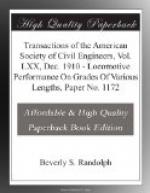TESTS OF CREOSOTED TIMBER.
By W. B. Gregory, M. Am. Soc. C. E.
During the last few years a quantity of literature has appeared in which the treatment of timber by preservatives has been discussed. The properties of timber, both treated and untreated, have been determined by the Forest Service, United States Department of Agriculture, and through its researches valuable knowledge has come to engineers who have to deal with the design of wooden structures. There is very little information, however, regarding the effect of time on creosoted timber, and for this reason the results given herewith may prove of interest.
The material tested consisted of southern pine stringers having a cross-section approximately 6 by 16 in. and a length of 30 ft. For the purpose of testing, each beam was cut into two parts, each about 15 ft. long. This material had been in use in a trestle of a railroad near New Orleans for 26 years. The stringers were chosen at random to determine the general condition of the trestle. The timber had been exposed to the weather and subjected to heavy train service from the time it was treated until it was tested. The annual rainfall at New Orleans is about 60 in., and the humidity of the air is high. In spite of these conditions, there was no appearance of decay on any of the specimens tested. The specifications under which the timber was treated were as follows:
TIMBER.
The timber for creosoting shall be long-leafed or southern pine. Sap surfaces on two or more sides are preferred.
Piles.—The piles shall be of long-leafed or southern pine, not less than 14 in. at the butt. They shall be free from defects impairing their strength, and shall be reasonably straight.
The piles shall be cleanly peeled, no inner skin being left on them. The oil used shall be so-called creosote oil, from London, England, and shall be of a heavy quality.
The treatment will vary according to the dimensions of the timbers and length of time they have been cut. Timbers of large and small dimensions shall not be treated in the same charge, neither shall timbers of differing stages of air seasoning, or the close-grained, be treated in the same charge with coarse or open-grained timbers.
The timbers shall be subjected first to live steam superheated to from 250 to 275 deg. Fahr., and under a 30 to 40-lb. pressure. The live steam shall be admitted into the cylinders through perforated steam pipes, and the temperature shall be obtained by using superheated steam in closed pipes in the cylinders.
The length of time this steaming shall last will depend on the size of the timbers and the length of time they have been cut. In piles and large timbers freshly cut, as long a time as 12 hours may be required. After the steaming is accomplished, the live steam shall be shut off and the superheated steam shall be maintained at a temperature of 160 deg. or more and a vacuum of from 20 to 25 in. shall be held for 4 hours or longer, if the discharge from the pumps indicates the necessity.




